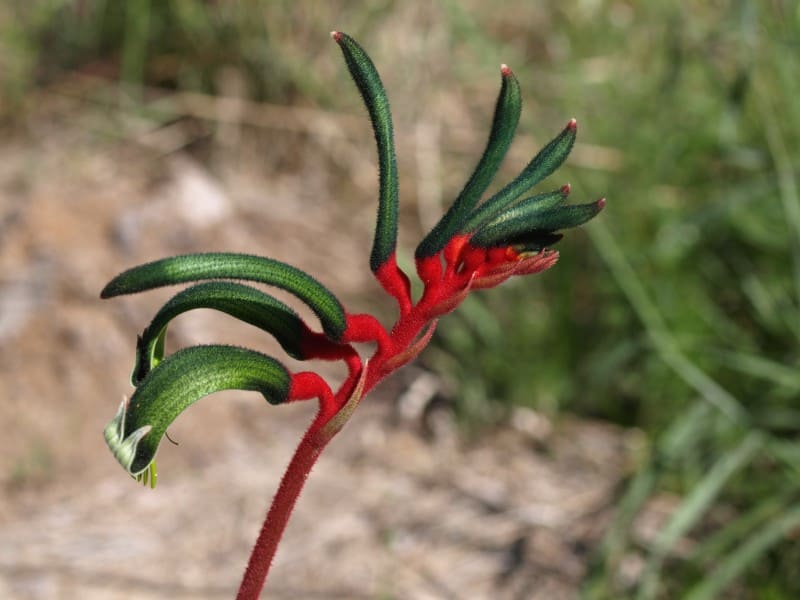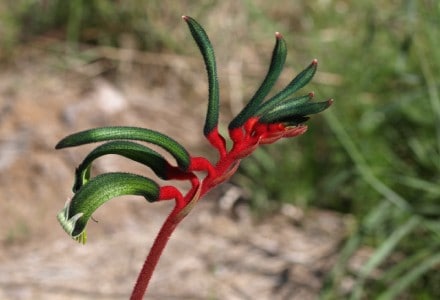
Kangaroo Paw Facts
- First of all, the highly descriptive term Kangaroo Paw apples to a variety of related species of remarkable flora. Secondly, the respected French botanist Jacques-Julien Houtou de Labillardière became the first known European to officially recognize the plant. The scientist made this fortunate discovery and subsequent recognition in the year 1792.
- Currently, botanists around the world recognize a total of 16 members of this remarkable group of plants including subspecies. Also surprisingly, these various varieties also occur across two separate genera. Further, the attention-grabbing common name understandably derives from its physical appearance. That’s because many believe the bloom resembles a paw.
- In addition, each of them ranks as a remarkably hardy flower, despite displaying a seemingly fragile nature. Although its natural range remains restricted, the Kangaroo Paw has now been introduced into several other parts of the world. That’s because the gorgeous species now lives in such locations as the United States, in North America, as a garden plant.
- For the moment, the IUCN does not list any of the members of this group of plants on its Red List of Threatened Species. However, that could potentially change in the foreseeable future. That’s because it now faces potential threats to its existence. One of these is habitat loss, given the small range. However, it also now faces the looming threat of climate change.
Related Articles
Sapphire Tower Colorado Columbine Orpheus Flower
Kangaroo Paw Physical Description
Since the term of Kangaroo Paw applies to so many different species, physical appearances naturally vary. In fact, somewhat significant variations in terms of physical size occur. Nevertheless, this particular measurement typically ranges among the species from 3 – 6 ft (0.91 -1.83 m).
However, the gorgeous blooms that it produces themselves remain its most noteworthy feature. These parts of the plant also vary in color among the species. These typically include varying shades of red, yellow, green, pink, orange, and even brown. But, the duo of red and green usually predominates.
Further, these flowers attain an average length among the different varieties of 4 in (10 cm). In addition, they develop in the dramatic tube shape. But the common name of Kangaroo Paw derives from the structure of the dense hair-like features. That’s because these line the apex of the flower, looking like claws or toes.
- Kingdom: Plantae
- Phylum: Magnoliophyta
- Class: Liliopsida
- Order: Commelinales
- Family: Haemodoraceae
- Genus: Anigozanthos
Photographer: Rozmiar pierwotny
CC License: http://bit.ly/2xWlULD
Kangaroo Paw Distribution, Habitat, and Ecology
Quite unfortunately, the stunning Kangaroo Paw only naturally inhabits a limited range of the world, rendering its situation tentative. That’s because all known varieties of the surprising and magnificent plant evolved as endemic to a highly restricted portion of Southwest Australia.
Even more specifically, it has very specific habitat requirements to flourish in the wild. As a result, in Nature, those plants known by this common name typically inhabit warm dry areas in its native environment. To be precise, it occurs naturally only in an area extending from the Murchison River to Lake Muir.
The various forms of the The Kangaroo Paw bloom from August to October. Additionally, pollination principally occurs via birds, rather than bees. In fact, plants of the group remain quite popular with local bird varieties. Its long, flowering stalks rise above surrounding undergrowth, thus attracting birds as a perch.
Consequently, the numerous birds represent its principal pollination source. The birds provide pollination when they feed upon the nectar within the flowers. This occurs because the shape of the flower causes pollen to be deposited on their heads, and then gets transferred to the next flower the bird visits.
Species Sharing Its Range
Tawny Frogmouth Numbat Thorny Dragon
Check out our other articles on 6 Mysterious Natural Phenomena, Vietnamese Mossy Frog, Havasu Falls, Basking Shark, Marbled Cat, Lange’s Metalmark Butterfly, Puffin

